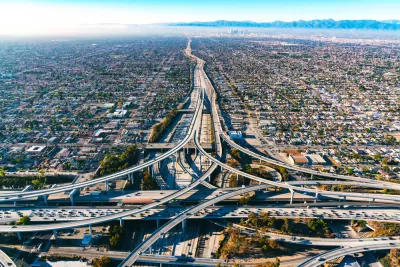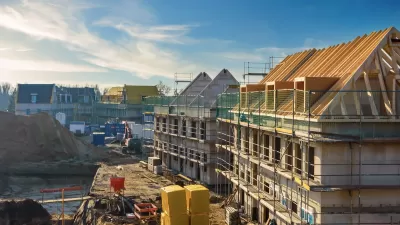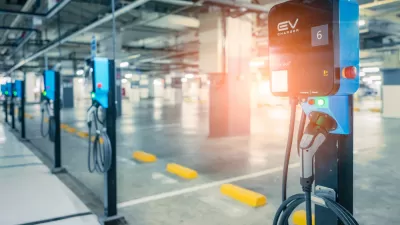If there has ever been a good time to change our urban patterns, the time is now.

The United States has a distinctive urban landscape: highways that go everywhere, single-family suburbs without sidewalks, and parking lots—lots of them. This results in a lifestyle where every member of society needs to own a motor vehicle in order to be independent (if you do not want to live miserably, that is). The reason for how we got to this point would require another essay, but let's just say it was more complicated than “Americans love their cars.”
Of course, there are exceptions. New York City, Chicago, Washington, D.C., and Portland offer respectable models for a car-light urban lifestyle. But even though these cities are vast, America’s population is vaster. According to the United States Census Bureau, America's population will soar to 458 million by 2050. This is an increase of 124 million from today or the equivalent of adding 15 New York Cities’ worth of population. Housing people has never been more important, and if we want to do it efficiently, something needs to change: America’s urban pattern.
So why not change it? For one, it is often illegal. One of the main complications is exclusionary zoning policies, which limit what can be built. This leads to the constriction of diversity in communities. Yet if this was the only problem it would be easy enough to abolish it. This leads us to the second—and more challenging—point: American culture.
We have all heard “wait til you’re older and you will love suburbs” or maybe the classic “raising kids is better in suburbia.” This is all due to the synthetic culture created by automobile makers who destroyed most of America’s urban landscapes for sustained profit. Automobile makers did all they could to promote their products. Are people getting killed by your products? Blame the victims! This is how the term jaywalking came to exist. Want people to use your products more? Monopolize the transportation system—by lobbying against public transit.
It’s easy to understand why a family in suburbia with a car (or two) seems to represent the American dream. This synthetic culture has ingrained in American minds that having a car and a house with a big lawn is the definition of success. Anything that is not the American Dream is looked down upon, reinforcing the false need to build more American Dream houses that can support the American Dream's main mode of transportation.

This has been the reality in America for most of the last century. But it doesn’t have to continue being the status quo. Now more than ever, young people appreciate the benefits of urban environments and an urban lifestyle. A study published by the Journal of Regional Science in 2019 shows that younger generations such as Millennials are more likely to live in high-density urban environments than Boomers at the same age. Meanwhile, Generation Z is also changing historic American trends. According to a publication by the New York Post, “Generation Z drives less each time, 18-year-olds who had their driver’s license in 2018 fell nearly 20 percent from 1983 (80% to 61%).” Some people blame the high cost of car ownership, while others say climate change awareness plays an important role too. Whatever the reason, the result is the same: young people drive less, and car culture is not as popular among young people as it was before.
Recent technological proliferation has also influenced change. Thanks to the internet and social media, education is easier than ever to access. For instance, TikTok, the popular and controversial video-based social media platform, started showing teens stuck in suburbs an alternative urban lifestyle. Teenagers, dependent their whole lives on mom’s car, started seeing videos of places where they could go everywhere by walking or using public transportation, asking themselves, “Why can’t we have this at home?” This questioning grew into in a rising interest in urban planning and an awareness of how urban design affects our lives. All of this could not have happened before the internet, when information was limited and people were unaware of the damages of suburbanization and car dependency. This made it easier for America to maintain its development patterns.
Let’s not forget about the housing shortage and climate change, which are negatively affected by traditional American urban development trends. There has never been a better time than today to change our ways. We had plenty of reasons in the past—but we have even more today.
Sooner or later, change will happen. In my opinion, the American urban paradigm is finally evolving. The same American culture that created car-dependent suburbia is losing its hegemony. Younger generations care less about cars than their predecessors and are increasingly aware of the problematic nature of car dependency, thanks largely to technology and the rise of the internet. At the same time, demand for urban spaces is high in the United States and, even in suburban areas, people want more places where they can experience the benefits of urban life such as walkable streets and public transit.
Americans were once robbed of their great urban environments. Now, it seems likely that they will start demanding them back.

Study: Maui’s Plan to Convert Vacation Rentals to Long-Term Housing Could Cause Nearly $1 Billion Economic Loss
The plan would reduce visitor accommodation by 25,% resulting in 1,900 jobs lost.

North Texas Transit Leaders Tout Benefits of TOD for Growing Region
At a summit focused on transit-oriented development, policymakers discussed how North Texas’ expanded light rail system can serve as a tool for economic growth.

Using Old Oil and Gas Wells for Green Energy Storage
Penn State researchers have found that repurposing abandoned oil and gas wells for geothermal-assisted compressed-air energy storage can boost efficiency, reduce environmental risks, and support clean energy and job transitions.

Santa Barbara Could Build Housing on County Land
County supervisors moved forward a proposal to build workforce housing on two county-owned parcels.

San Mateo Formally Opposes Freeway Project
The city council will send a letter to Caltrans urging the agency to reconsider a plan to expand the 101 through the city of San Mateo.

A Bronx Community Fights to Have its Voice Heard
After organizing and giving input for decades, the community around the Kingsbridge Armory might actually see it redeveloped — and they want to continue to have a say in how it goes.
Urban Design for Planners 1: Software Tools
This six-course series explores essential urban design concepts using open source software and equips planners with the tools they need to participate fully in the urban design process.
Planning for Universal Design
Learn the tools for implementing Universal Design in planning regulations.
Ascent Environmental
Borough of Carlisle
Institute for Housing and Urban Development Studies (IHS)
City of Grandview
Harvard GSD Executive Education
Toledo-Lucas County Plan Commissions
Salt Lake City
NYU Wagner Graduate School of Public Service





























